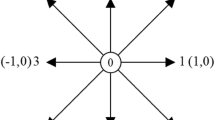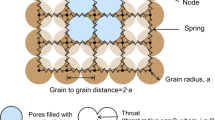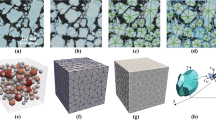Abstract
A lattice spring model is developed for coupled fluid flow and deformation problems. The model has an underlying structure consisting of particles connected by springs for the solid and fluid bubbles, connected by fluid pipelines for fluid flow. Formulations of the model to describe the coupled fluid flow and deformation behavior of a solid are derived. A few examples of consolidation problems are presented and compared with analytical solutions with good agreement being obtained, which means that the lattice model developed in this study can correctly simulate the coupled fluid flow and deformation response of a solid.





















Similar content being viewed by others
Abbreviations
- A 0 :
-
The total area of the interface between the fluid bubble and solid particle
- A c :
-
The contact area between the solid particles
- A ele :
-
The area of the triangle element
- A p :
-
The cross-sectional area of the pipe
- \( \bar{A} \) :
-
The area of the model
- B :
-
The strain interpolation matrix of the bond
- c f :
-
The compressibility of the fluid
- C g :
-
The compressibility of the solid grain
- C s :
-
The compressibility of the skeleton
- C global :
-
The global matrix of pore pressure and particle force relationship
- E :
-
The Young’s modulus
- E g :
-
The elastic modulus of solid particle
- E s :
-
The elastic modulus of porous material
- F :
-
The vector of particle forces
- F pore ij :
-
The forces of the jth fluid bubble applied on the ith solid particle
- F pore :
-
The vector of the solid particle forces induced from pore pressure of all the fluid bubbles
- F R :
-
The vector of external forces applied at all the particles
- H global :
-
The global flux pressure matrix
- H pipe :
-
The flux pressure matrix of a fluid pipe
- k :
-
The permeability of a material
- k n :
-
The normal stiffness of a bond
- k p :
-
The permeability of the pipe
- k s :
-
The shear stiffness of a bond
- K bond :
-
The bond stiffness matrix under the local coordinate system
- K b :
-
The element stiffness matrix of each bond under the global coordinate system
- K global :
-
The global stiffness matrix
- l i :
-
The length of the ith bond
- l p :
-
The length of the fluid pipe
- \( l_{ij}^{{\Upgamma_{0} }} \) :
-
The length of the straight line interface between the ith particle and jth fluid bubble
- M :
-
The number of pipes contained within V
- M global :
-
The global matrix of the fluid discharges and variation of fluid bubble pressures
- n p :
-
The porosity
- n pipe i :
-
The ith component of unit vector directed along the pipe
- n x :
-
The x component of the normal direction vector of the bond
- n y :
-
The y component of the normal direction vector of the bond
- n Γ :
-
The outer normal vector of the fluid–solid interface
- \( {\mathbf{n}}_{ij}^{{\Upgamma_{0} }} \) :
-
The outer normal of the straight line interface between the ith particle and jth fluid bubble
- N e i :
-
The element shape function associated with particle i
- N i,x :
-
The diffusive derivative of the shape function N i in x direction
- N i,y :
-
The diffusive derivative of the shape function N i in y direction
- p :
-
The pore water pressure
- p i :
-
The fluid pressure of the ith bubble
- \( {{\Updelta}}p \) :
-
The pressure difference across the pipe
- P :
-
The vector of pore pressure of the fluid bubbles
- \( {\dot{\mathbf{P}}} \) :
-
The vector of variation of fluid bubble pressures
- q i :
-
The fluid flux of the ith bubble
- q macro i :
-
The macroscopic fluid flux
- q move ji :
-
The fluid discharge of the jth fluid bubble caused from the movement of the ith particle
- q p :
-
The fluid discharge caused by the variation of pressure
- q pipe i :
-
The fluid flux through the pipe in the ith direction
- \( \langle {q_{i} } \rangle \) :
-
The average fluid flux in the ith direction of a given volume V
- Q pipe :
-
The discharge in the pipe
- Q :
-
The vector of bubble fluid flux
- Q move :
-
The vector of the fluid discharge induced from the particle movements
- Q pressure :
-
The vector of the fluid discharges induced from variation of fluid bubble pressures
- Q R :
-
The vector of external discharges of the fluid bubbles
- r :
-
The distance between a point and the reference point
- r max :
-
The maximum distance between the reference point and the particles (nodes)
- s :
-
The strain vector composed of the three strain components of a spring bond
- t D :
-
The dimensionless time
- \( {{\Updelta}}t \) :
-
The time step
- T :
-
The transform matrix
- u i :
-
The displacement in x direction of particle i
- \( \hat{u}^{\text{n}} \) :
-
The normal deformation of a bond
- \( \hat{u}^{\text{s}} \) :
-
The shear deformation of a bond
- u :
-
The displacement vector of the particles
- \( {\hat{\mathbf{u}}} \) :
-
The vector of local deformation of a spring bond
- v i :
-
The displacement in y direction of particle i
- x i :
-
The x coordinate of the ith particle (node)
- x m1 :
-
The middle point of the spring bond i–k
- x m2 :
-
The middle point of the spring bond i–l
- y i :
-
The y coordinate of the ith particle (node)
- \( {\dot{\mathbf{u}}}_{i} \) :
-
The velocity vector of the ith particle
- U :
-
The vector of particle displacements of all the particles
- \( {\dot{\mathbf{U}}} \) :
-
The vector of particle velocities of all the particles
- V :
-
The volume of the model
- α :
-
The growth factor of time step (α ≥ 1.0)
- α 2D :
-
A coefficient determined by the geometry data of the lattice model
- δ :
-
The effective contact area ratio between solid particle and fluid bubble
- δ * t :
-
The limit value the bond’s stretching
- η :
-
A variable defined as \( \eta = \left( {\frac{{A^{\text{p}} k^{\text{p}} }}{\mu }} \right)^{ - 1} \)
- μ :
-
The dynamic viscosity of the fluid
- ν :
-
The Poisson’s ratio
- \( {{\Updelta}}\sigma \) :
-
The applied surcharge
- \( {{\Updelta}} \) :
-
The unit length in the third dimension
- \( {{\Upgamma}}_{ij} \) :
-
The interface between the ith solid particle and jth fluid bubble
- \( \hbox{d}{{\Upgamma}} \) :
-
The differential contact area between fluid bubble and solid particle
- \( \hbox{d}{{\Upgamma}}^{*} \) :
-
The differential effective contact area between fluid bubble and the solid particle
- \( {{\Uppi}}^{\mathrm{b}} \) :
-
The strain energy of the bond
References
ANSYS Inc (2010) VM260 two-dimensional consolidation settlement problem. ANSYS User’s Manual
Biot MA (1941) General theory of three-dimensional consolidation. J Appl Phys 12:155–164
Boutt DF, Cook BK, Williams JR (2011) A coupled fluid-solid model for problems in geomechanics: application to sand production. Int J Numer Anal Meth Geomech 35:997–1018
Breitkopf P, Rassineux A, Touzot G, Villon P (2000) Explicit form and efficient computation of MLS shape functions and their derivatives. Int J Numer Meth Eng 48(3):451–466
Clough RW (1960) The finite element method in plane stress analysis. Proc Secon ASCE Conf Elec Compu, Pittsburg 345
Cook B, Nobel D, Williams J (2004) A direct simulation method for particle-fluid systems. Eng Comput 21:151–168
Cusatis G, Bažant ZP, Cedolin L (2003) Confinement-shear lattice model for concrete damage in tension and compression. I: Theory. J Eng Mech 129(12):1439–1448
Darve F, Nicot F. (2005) On incremental non-linearity in granular media: phenomenological and multi-scale views (Part I). Int J Numer Anal Meth Geomech 29:1387–1409
Feng YT, Han K, Owen DRJ (2007) Coupled lattice Boltzmann method and discrete element modelling of particle transport in turbulent fluid flows: computational issues. Int J Numer Meth Eng 72:1111–1134
Flekkoy EG, Malthe-Sorenssen A (2002) Modeling hydrofracture. J Geophys Res B8:2151. doi:10.1029/2000JB000132
Hahn M, Wallmersperger T, Kroplin BH (2010) Discrete element representation of continua: proof of concept and determination of the material parameters. Comput Mater Sci 50:391–402
Hrennikoff A (1941) Solution of problems of elasticity by the framework method. ASME J Appl Mech 8:A619–A715
Hsieh YM, Li HH, Huang TH, Jeng FS (2008) Interpretations on how the macroscopic mechanical behavior of sandstone affected by microscopic properties revealed by bonded-particle model. Eng Geol 99:1–10
Jain AK, Juanes R (2009) Preferential mode of gas invasion in sediments: grain-scale mechanistic model of coupled multiphase fluid flow and sediment mechanics. J Geophys Res 114:B08101–B08119
Kawai T (1978) New discrete models and their application to seismic response analysis of structures. Nucl Eng Des 48(1):207–229
Khoshghalb A, Khalili N, Selvadurai APS (2010) A three-point time discretization technique for parabolic partial differential equations. Int J Numer Anal Meth Geomech 35(3):406–418
Kozicki J, Tejchman J (2008) Modelling of fracture process in concrete using a novel lattice model. Granular Matter 10(5):377–388
Mustoe GGW (1992) Generalized formulation of the discrete element method. Eng Comput 9(2):181–190
Ostoja-Starzewski M (2002) Lattice models in micromechanics. Appl Mech Rev 55(1):35–59
Parisi A, Caldarelli G (2000) Self-affine properties of fractures in brittle materials. Physica A: Stat Mech Appl 280(1):161–165
Potyondy DO, Cundall PA (2004) A bonded-particle model for rock. Int J Rock Mech Min Sci 41(8):1329–1364
Sakaguchi H, Muhlhaus HB (2000) Hybrid modelling of coupled pore fluid-solid deformation problems. Pure Appl Geophys 157:1889–1904
Schiffman RL, Chen ATF, Jordan JC (1969) An analysis of consolidation theories. J Soil Mech Found Div, ASCE 95(SM1):285–312
Terzaghi K, Peck RB (1976) Soil mechanics in engineering practice, 2nd edn. Wiley, New York
Tsuji Y, Kawaguchi T, Tanaka T (1993) Discrete particle simulation of two-dimensional fluidized bed. Powder Tech 77:79–87
Wang G, Al-Ostaz A, Cheng AHD, Mantena PR (2009) Hybrid lattice particle modeling: theoretical considerations for a 2D elastic spring network for dynamic fracture simulations. Comput Mater Sci 44(4):1126–1134
Zhao GF (2010) Development of micro-macro continuum-discontinuum coupled numerical method. PhD thesis, EPFL, Switzerland
Zhao GF, Khalili N (2012) Graphics processing unit based parallelization of the distinct lattice spring model. Comput Geotech 42:109–117
Zhao SF, Zhao GF (2012) Implementation of a high order lattice spring model for elasticity. Int J Solids Struct. doi:10.1016/j.ijsolstr.2012.05.015
Zhao GF, Fang J, Zhao J (2011a) A 3D distinct lattice spring model for elasticity and dynamic failure. Int J Numer Anal Meth Geomech 35:859–885
Zhao GF, Fang JN, Sun L, Zhao J (2011b) Parallelization of the distinct lattice spring model. Int J Numer Anal Meth Geomech. doi:10.1002/nag.1085
Zhao GF, Khalili N, Fang J, Zhao J (2012) A coupled distinct lattice spring model for rock failure under dynamic loads. Comput Geotech 42:1–20
Author information
Authors and Affiliations
Corresponding author
Rights and permissions
About this article
Cite this article
Zhao, G., Khalili, N. A Lattice Spring Model for Coupled Fluid Flow and Deformation Problems in Geomechanics. Rock Mech Rock Eng 45, 781–799 (2012). https://doi.org/10.1007/s00603-012-0291-5
Received:
Accepted:
Published:
Issue Date:
DOI: https://doi.org/10.1007/s00603-012-0291-5




